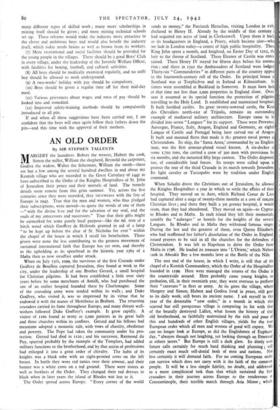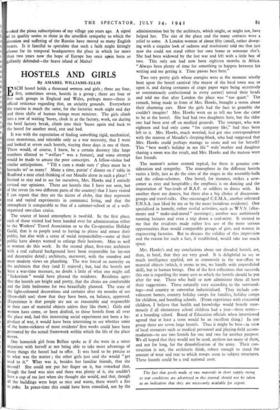AN OLD ORDER
By Silt STEPHEN TALLENTS
MARGERY the laundress. Robert the weaver, Hubert the cook, Simon the miller, William the shepherd, Reynold the carpenter, Godiva the widow, Walter the fisherman, William the smith—these are but a few among the several hundred dwellers in and about my
Kentish village who are recorded in the Great Cartulary of 1442 to have subscribed to the Order of the Knights Hospitallers of St. John of Jerusalem their pence and their morsels of land. The homely details seem remote from this grim summer. Yet, across the five centuries since they were recorded, they interweave with the fate of Europe in 1942. True that the men and women, who thus pledged their subscriptions, were moved—to quote the words of one of them —" with the divine love and for the salvation of my soul, and the souls of my antecessors and successors." True that their gifts might be earmarked for some purely local purpose—like the 6d. rent of a birch wood which Geoffrey de Heilonde granted in aid of a lamp " to be kept up before the altar of St. Nicholas for ever " within the chapel of the house in which I recall his benefaction. Those givers were none the less contributing to the greatest movement of sustained international faith that Europe has yet seen, and thereby to the upholding as its spearhead in the historic year 1565 of a Malta then as now steadfast under attack.
When on July t5th, 1o99, the survivors of the first Crusade under Godfrey de Bouillon captured Jerusalem, they found at work in the city, under the leadership of one Brother Gerard, a small hospital for Christian pilgrims. It had been established a little over sixty years before by some merchants of Amalfi, who had purchased the site of an earlier hospital founded there by Charlemagne. Some of the crusading army were tended within its walls ; and Duke Godfrey, who visited it, was so impressed by its virtue that he endowed it with the manor of Montboise in Brabant. The returning crusaders carried its fame throughout Europe, and many distant well- wishers followed Duke Godfrey's example. It grew rapidly. A visitor of 116o found as many as 2,000 patients in its great halls and three churches within its confines. Gerard and his fellows had meantime adopted a monastic rule, with vows of chastity, obedience and poverty. The Pope had taken the community under his pro- tection. Gerard had died in 1120 ; and his successor, Raymond du Puy, spurred probably by the example of the Templars, had added military functions to the brotherhood, and by that union of professions had enlarged it into a great order of chivalry. The habit of its knights was a black robe with an eight-pointed cross on the left breast. In battle they wore red tunics over their armour, and their banner was a white cross on a red ground. There were sisters as well as brothers of the Order. They changed their red dresses to black when in later years the island of Rhodes was lost to it.
The Order spread across Europe. " Every corner of the world
sends us money," the Patriarch Heraclius, visiting London in 118 declared to Henry II. Already by the middle of that century had acquired ten acres of land in Clerkenwell. Upon them it built as its headquarters in England, a Priory, which became .also—wha we lack in London today—a centre of high public hospitality. There King John spent a month, and knighted, on Easter Day of 1212, the heir to the throne of Scotland. There Eleanor of Castile was enter. mined. There Henry IV stayed for fifteen days before his corona. tion ; and there in 15o1 the Ambassadors of Scotland were lodged Thirty-six " Commanderies " in different parts of the country appeal in the fourteenth-century roll of the Order. Its principal house it Scotland was at Torphichen and in Ireland at Kilmainham. Its sisters were assembled at Buckland in Somerset. It must have held at that time not less than 2,000 properties in England alone. Over- seas it assumed as its special function the protection of pilgrims travelling to the Holy Land. It established and maintained hospitals, It built fortified castles. Its great twenty-towered castle, the Krak des Chevaliers north-east of Tripolis, remains an outstanding example of mediaeval military architecture. Europe came to be divided into seven " Langues " for its support. These were Provence, Auvergne, France, Italy, Aragon, England and Germany, an eighth Langue of Castile and Portugal being later carved out of Aragon. It built and manned fleets that made it the greatest naval power in Christendom. Its ship, the ' Santa Anna,' commanded by an English- man, was the first armour-plated vessel known. A six-decker of some 1,70o tons, she carried a crew of 300 men with provisions for six months, and she mounted fifty large cannon. The Order disposed, too, of considerable land forces. Its troops were called upon to protect the rear of the third Crusade in its march towards Jerusalem. Its light cavalry or Turcopoles were by tradition under English command.
When Saladin drove the Christians out of Jerusalem, he allowed the Knights Hospitallers a year in which to settle the affairs of their hospital. They moved on to Acre, which Richard Coeur de Lion had captured after a siege of twenty-three months at a cost of ioo,000 Christian lives ; and there they built a yet greater hospital, it would seem, than they had abandoned. They moved on again—to Cyprus, to Rhodes and to Malta. In each island they left their memorials, notably the " auberges or hostels for the knights of the several Langues. In Rhodes and in Malta they withstood famous sieges. During the last and the greatest of them, even Queen Elizabeth, who had reaffirmed her father's dissolution of the Order in England, issued prayers to be said in all the churches for the defenders of Christendom. It was left to Napoleon to drive the Order from Malta in 1798. He loaded its treasure into L'Orient,' which Nelson sank in Aboukir Bay a few months later at the Battle of the Nile.
The east end of the house, in which I write, is still that of the chapel of a Kentish Commandery, which the Order of the Hospitallers founded in tr99. Here were managed the estates of the Order in the countryside around. Here probably came young knights on probation, till, in their twentieth year, they went overseas to perform their " caravans " in fleet or army. At its gates the village, where Margery and Simon, Hubert and Godiva lived in peace, still goes to its daily work, still bears its ancient name. I ask myself in this year of the detestable "new order," in a month in which this scarred but still prosperous village is comparing its lot with that of the brutally destroyed Lidice, what lesson the history of that old brotherhood, so faithfully maintained by the rich and poor of this and hundreds of other English villages, yields for the true European order which all men and women of good will expect. We can no longer look at Europe, as did the Englishmen of Euphues' day, " alwayes though not laughing, yet looking through an Emeraud at others jarres." But Europe is still a dark glass. Its dimly seen future calls certainly for much hard thinking and planning ; will certainly exact much self-denial both of men and nations. Not less certainly it will demand faith. For no coming European order can survive which does not carry with it the faith of the common people. It will be a less simple fidelity, no doubt, and addressed to a more complicated task than that which sustained the first crusaders in their journey across Europe to the rendezvous at Constantinople, their terrible march through Asia Minor ; which
yoked the pious subscriptions of my village soo years ago. A signal f its quality seems to shine in the unselfish sympathy to which the evotion and suffering of the Russias have moved so many English hearts. Is it fanciful to speculate that such a faith might fittingly hoose for its temporal headquarters the place in which for more than two years now the hope of Europe has once again been so allantly defended—the brave island of Malta?



























 Previous page
Previous page